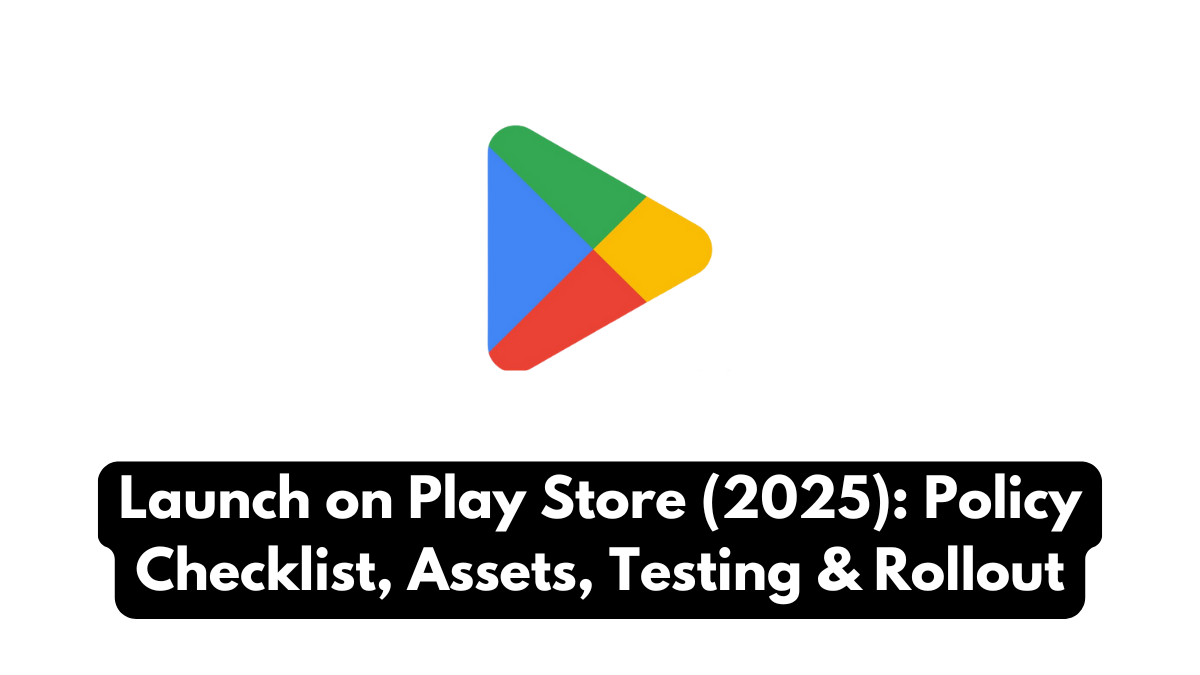Launching a mobile application successfully requires a thorough understanding of Google’s policies and a well-structured app launch guide. With the 2025 updates in place, developers need to pay attention to policy, compliance, proper asset preparation, and testing before initiating the official Launch on Play Store. Missing even a minor step can result in app rejection, delayed rollout, or policy violations.
This comprehensive Launch on Play Store guide will walk you through essential steps including policy adherence, asset management, testing protocols, and deployment strategies to ensure your app reaches users efficiently while avoiding common pitfalls.

Understanding Google Play Store Policies
One of the first and most critical steps in your app launch guide is ensuring compliance with Google Play Store policy. Google updates its guidelines frequently to protect users and maintain platform quality. Non-compliance can result in rejection or suspension of your app.
Key policy requirements include:
- Content Policy: Ensure your app does not contain offensive, harmful, or copyrighted content.
- Data Safety: Clearly disclose how user data is collected, stored, and used.
- Ads and Monetization: Follow Google’s regulations for ads, in-app purchases, and subscriptions.
- Target Audience: Apps aimed at children must comply with COPPA and similar regulations.
Following the policy checklist ensures that your app maintains credibility and avoids unnecessary delays during review.
Preparing App Assets for Launch
Proper asset preparation is crucial for a smooth Launch on Play Store. Your app launch guide should include the creation of visually appealing and compliant assets to attract users and ensure clarity in the Play Store listing.
Essential assets include:
- App Icon: Must be high-resolution and conform to Google’s specifications.
- Screenshots: Showcase core functionalities across different device types.
- Promo Video: Optional but recommended for better engagement.
- Feature Graphics: Improves discoverability in Play Store search results.
- Description: Include primary keywords and concise details of features and benefits.
Table: Key Assets and Specifications
| Asset | Recommended Specs | Notes |
|---|---|---|
| App Icon | 512×512 px | PNG format, transparent background preferred |
| Screenshots | 1080×1920 px | Minimum 2, maximum 8, landscape & portrait |
| Promo Video | 30–60 seconds | Optional, hosted on YouTube |
| Feature Graphic | 1024×500 px | JPEG/PNG format, attractive visual |
| Description | 4000 characters | Keyword-rich, clear, concise |
Well-prepared assets not only enhance user experience but also improve the chances of a successful approval during the review process.
Testing and Quality Assurance
Testing is a critical stage in the app launch guide. Even if your code is flawless, errors in user experience, UI compatibility, or backend connectivity can lead to poor ratings and negative reviews. Proper testing ensures your app functions flawlessly across devices and Android versions.
Testing steps include:
- Functional Testing: Verify all app functionalities work as intended.
- Compatibility Testing: Check performance across different devices, screen sizes, and OS versions.
- Beta Testing: Collect user feedback through Google Play Beta channels.
- Security Testing: Ensure data privacy and encryption meet Play Store policy standards.
By thoroughly testing the app before release, you reduce the risk of critical issues post-launch and improve user satisfaction.
Rollout Strategies for Successful Launch
After preparing assets, ensuring policy compliance, and completing testing, the next step is the Launch on Play Store rollout. Google offers several deployment strategies to control the app release and gather feedback.
Recommended rollout approaches:
- Staged Rollout: Release the app to a small percentage of users initially and expand gradually.
- Country-Specific Release: Target select countries for the initial launch.
- Soft Launch: Collect real-user feedback and fix minor issues before global release.
- Full Release: Only recommended once testing and beta feedback are complete.
Following these rollout strategies ensures your app maintains stability and meets user expectations while mitigating risks during launch.
Conclusion
Successfully completing a Launch on Play Store in 2025 requires attention to detail across policy compliance, asset preparation, testing, and rollout planning. By following this structured app launch guide and adhering to the policy checklist, developers can ensure a smooth approval process and deliver a positive user experience. Proper planning, combined with staged testing and strategic rollout, is key to maximizing app success and minimizing post-launch issues.
FAQs
What is the first step in launching an app on Play Store?
The first step in your app launch guide is ensuring full compliance with Google Play Store policy to avoid rejection during review.
What assets are required for a Play Store launch?
Essential assets include a high-resolution app icon, screenshots, promo video, feature graphic, and a keyword-rich description.
How should testing be conducted before launch?
Testing should include functional, compatibility, beta, and security testing to meet quality standards and Play Store policy requirements.
What is a staged rollout?
A staged rollout allows developers to release the app to a small percentage of users initially, gradually expanding after feedback and monitoring stability.
Why is adherence to Play Store policy important?
Following the policy checklist ensures app approval, protects user data, and maintains the integrity of your Launch on Play Store process.
Click here to know more.